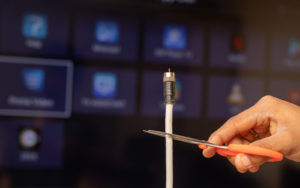
Today we’ll be covering the accelerated rise of Connected TV. To be clear, it feels weird to call this an accelerated rise when Connected TV’s popularity among marketers and brands was already growing at a crazy rate.
Unfortunately, due to COVID-19’s impact on the economy, there are many people who choosing to cut back. One way that they’re doing that is cutting the cord with cable.
Cutting The Cord
According to the The Daily Mail, TV cord-cutting has hit a new record as the largest paid subscription services for live multichannel TV packages have made another 2.3 million in the first quarter. Cable and satellite services have dropped by nearly 7% compared to 2022.
 This is due to there being a limit on new content that is available. It’s a tough choice for consumers to justify continuing to pay traditional TV prices for recycled content. Especially considering you can have quality, on-demand content for a fraction of the price from some of the big streaming platforms (Hulu, Netflix, etc.)
This is due to there being a limit on new content that is available. It’s a tough choice for consumers to justify continuing to pay traditional TV prices for recycled content. Especially considering you can have quality, on-demand content for a fraction of the price from some of the big streaming platforms (Hulu, Netflix, etc.)
As a result, streaming services like Disney + have seen a huge surge in paid subscriptions since this pandemic started. Based on Statista’s recent reports, Disney + jumped up from 33.5 million paid subscribers in 2020 to 146.7 million in 2023. This isn’t surprising when you look at the data from Nielsen about streaming behaviors during times like these.
According to Nielsen, viewers stream 61% more Connected TV during a crisis. Whether the crisis is a global pandemic or a major snowstorm, consumers stay inside and binge content.
Something to note is that the sentiment behind ad-supported streaming is on the rise. According to a survey on streaming trends from the IAS, current consumers are more willing to watch ads alongside content to control subscription costs. This could be due to subscription fatigue, or possibly the current economic state. It aligns with what we’ve seen from the cord-cutting records that the tv industry has suffered.
When Did Connected TV Become Popular?
Connected TV isn’t new to marketers. The demand and popularity have always been growing year over year but the current state of affairs has just increased it in numbers we never expected. It’s time for brands to pivot and start incorporating Connected TV as a supplement to their marketing strategy. People aren’t going out as often as they were in the past and they’re staying home to stream content.
The data that we’ve been accumulating, due to users operating/purchasing things online, is fueling not only Connected TV, but the digital marketing industry. Using current online behavior data, we can help ensure your ads are getting to the right people at the right time – when they’re in the market for your product or service.
It’ll be interesting to see how the Connected TV market continues to develop and transform as the world’s behaviors continue to evolve.